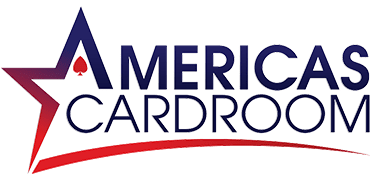Mistake #1: Ignoring Rake Load
Inexperienced players often underestimate how much the rake affects the ranges they play. Many defend too wide because they have seen charts from friends playing at higher limits or found leaked charts of top players from high stakes. Players try to copy this strategy, not realizing that the rake eats up a significant portion of the profit from marginal hands.
The lower the limit, the higher the rake load. At limits up to NL10, it is approximately 10-12 bb per 100 hands. Imagine: if your win rate is 20bb/100, then due to the rake, it will actually be halved.
The main thing to understand is that the rake mostly hurts the caller, not the raiser. Therefore, our open-raise frequency will hardly change as the rake increases or decreases, but when we face an open-raise or 3-bet, we should fold more. Let's look at this using three rake models as an example – NL25, NL1k and chipEV. Let's take a situation where EP opened with a 2bb sizing and everyone folded to BB. Here's a comparison of the defense frequencies:
- NL25: Call 31.3%, 3-bet 5.1%, Fold 63.6%;
- NL1K: Call 41.4%, 3-bet 4.5%, Fold 54.1%;
- chipEV: Call 50%, 3-bet 4%, Fold 45.8%.
At the same time, the frequencies of open-raises on EP practically do not change: on NL25 and NL1k, you need to open according to the solver in 18.2% of cases, and even according to chipEV, when there is no rake at all, the solver adds only 0.6%.
How does rake affect our 3-bet? The higher the rake, the more often the open-raiser should fold, including to a 3-bet. Our strategy should take this into account: if we play at a limit with a high rake and the opponent will fold a lot, then we 3-bet big and polarly. At limits with a low rake, the opponent will call more often – accordingly, we do not want to play 3-bet pots with trash without posturing, and our 3-bet becomes more linear.
This is what GTO 3-bet BB vs BU looks like against 2x sizing at NL10 and NL1k:
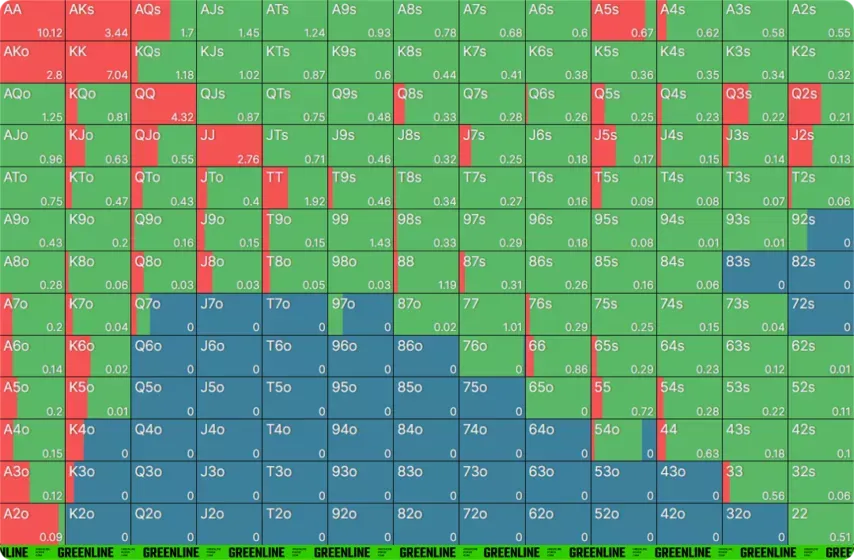 Defense at NL10
Defense at NL10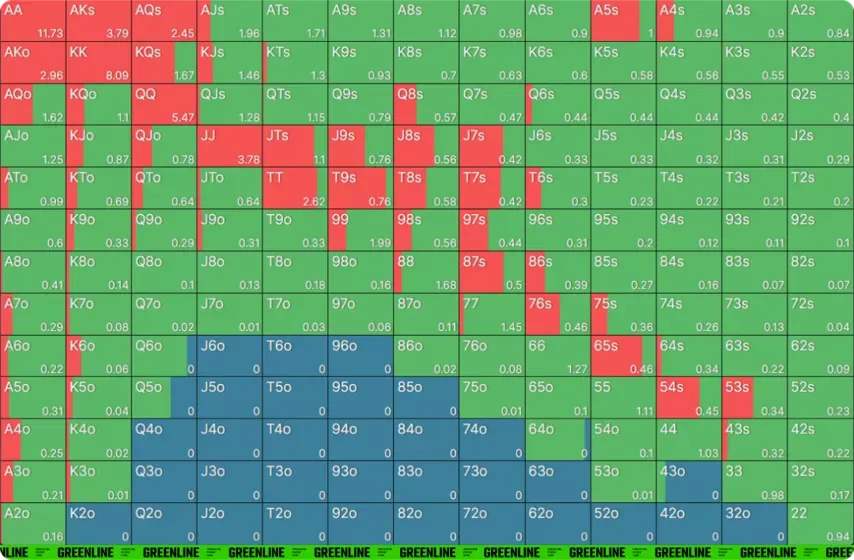 Protection at NL1000
Protection at NL1000There is a general rule that will work as an exploit: if you expect a lot of folds and 4-bets, use polarized 3-bets to avoid folding your middling range to 4-bets. If you expect a lot of calls, use linear 3-bets to avoid playing trash without posture and dominate your opponent's calling range.
Mistake #2: Tilt and Poker-Related Factors
Very often, players use tilt to justify their actions. For example, they explain a bad call, "although they usually don't play like that." Maybe they really don't play, but it doesn't mean that tilt should be ignored! On the contrary, it should be dealt with first and foremost, because, in the long run, tilt shoves and calls significantly drag down the win rate.
I had a friend who was playing NL10 successfully, showing a win rate of about 11-12bb/100. But when things didn't work out and he got run over a few times, he would try to win it back at NL100. This usually ended with him losing another 3-4 stacks, and then spending a month recouping his losses at NL10. Losing 4 stacks at 100 is the equivalent of 40 stacks at NL10, which is about a month of work for an average regular with a win rate of 6-7bb/100.
You can tell a bunch of different stories, but they all boil down to literally one: "Oh, I pushed in here on tilt, and then I didn't give a shit and called, etc." All this simply slows down your progress through the limits and hurts your win rate.
As an example, take a typical NL10 reg who plays 25k hands per month with a win rate of 5bb/100. His tilt actions are already included in his win rate. Let's say he loses 4 stacks to tilt per month. Then his expectation is:
25,000 / 100 x 0.5 = $125 per month.
Now let's add here 4 stacks that he might not have filled if he hadn't tilted:
125 + 40 = 25000 \ 100 x X
X = 165 \ 250 = 0.66
As you can see, the win rate grows to 6.6bb/100! Just free 1.6bb/100, for which, we don't have to do anything at all: no need to study any complex concepts, no need to select. It's enough to stop making random moves at the tables.
Don't forget about poker-related issues. If you play when you're tired after work, it leads to suboptimal decisions. For example, I play poorly when I'm hungry, so I always quit when I feel hungry. For others, it could be fatigue or psychological issues. Even a minor argument with a family member can knock you out of your normal state. You can't ignore these factors and sit down to play thinking that nothing bad will happen.
If you feel internal discomfort or you just don't want to play, it's better not to sit at the table. This will save you a lot of money and nerves.
Mistake #3: Lack of Game Development
Many at micro limits try to play a lot, thinking that they will learn as they go. This is highly debatable! I would advise dividing the time 50/50: if you play 4 hours a day, then devote another 4 hours to theory.
It is also worth remembering about efficiency. For example, there is no point in watching educational videos in the background, listening with half an ear: most likely, nothing will be fixed in long-term memory. I will give some advice on how to better study theory.
Try to take notes on the material to engage your visual memory.
A universal tip for practicing spots is to come up with assignments for yourself. After training, I always leave homework for my students. For example, we practiced playing against checks in SRP, and I ask them to note down 5-10 hands in a situation where he bet the turn or river BB against BU after a black/black flop, and another 5-10 hands in a spot BB against SB after a check from SB on any of the streets.
After receiving the task, you will look for spots in the game where you can consolidate the knowledge you have gained. I check everything with my students and give feedback, but even if you are studying alone, you can control yourself in this way.
The commentary format works well. Turn on the recording and play your standard session for an hour, voicing all your thoughts on the hands out loud, as if you were streaming. In a couple of days, watch the recording. During the game, something may seem like a good idea, but then, watching the recording again, you will find many mistakes from the outside.
Focus on what you've learned and work on it. For example, if you've watched a video about overbets, take a couple of days and focus on overbets. You don't need to watch overbets today, BB protection tomorrow, and playing with fish the day after, trying to apply everything at once. Work on your points and focus on certain aspects.
Mistake #4: Chasing Quantity and Over-Multi-Tabling
I often see people playing 8-9 tables without having time to think about important decisions.
Imagine you watched a video on BB defense and want to practice certain sizings, check-raises, and bluffs. When playing a lot of tables, it's easy to miss the right situations. So I recommend setting aside at least 1-2 days a week where you play 2-3 tables and think about each hand as much as possible. Over time, your results will start to improve because the points you practice will start to stick in your head.
Grinding is a good way to increase your income when you have achieved a certain win rate in your chosen game. For example, if you play with a win rate of 10-12bb/100, grinding will increase your dollar per hour, even if your win rate drops a little. But if your win rate is 0, 1, 2, or 3 bb per 100, nothing will change: you will play more, but your results will not improve.
Mistake #5: Trying to Figure Everything Out Alone
When you try to figure something out on your own, you are bombarded with a ton of information, some useful, some not so useful. It is very difficult to filter this information on your own.
I recommend setting aside a budget and contacting a coach who plays a couple of stake levels above yours. For example, if you play NL10 at zero or a small plus, then any winning coach with NL25 or NL50 will be able to tell you a lot of useful information that you would have to learn on your own for a very long time. These people have already passed your limits and know which plays work at them. It is especially important if the coach has successful students: this means that he not only understands how to win – but can also teach others.
Why exactly a two levels higher? I would not advise contacting regs who play much higher. Firstly, it is trivially expensive. Playing NL25, spending $500 bucks on one training means paying 20 stacks at those stakes. Secondly, you may not understand what they are trying to tell you because of the difference in the level of understanding. Like in school: if you want to teach a child to read, you do not need to involve a professor from Oxford, a simple adult is enough. The same in poker: for maximum efficiency, your mentor should be just a couple of steps higher than you.
I once played NL10 for a long time with a small win rate, about 2bb/100. Then I turned to a friend who played NL100 and took a couple of training sessions and later went to a few lessons with another coach from GipsyTeam. This gave me a boost that I would not have received on my own in a year.
Don't try to save every penny you can on a coach, and it will pay off. Let's say you spend $100 on training, but you will grow in limits faster and start earning more. This is better than playing NL5 and NL10 for years without progress.
Editor's note: We've compiled a list of the best micro-stakes poker rooms for cash games and MTTs. If you're working your way through the stakes from the bottom, these rooms will suit you well.
Mistake #6: Incorrect Preflop Strategies
Preflop is the foundation of any strategy, it shapes subsequent actions. If you got into a hand with the wrong hands, the situation can only get worse postflop, and the further the street, the more expensive the mistake. If preflop the solver shows you the EV of the action is -0.1bb, by the river the mistake can cost 30bb.
The problem may not only be in the wrong preflop, but also in the fact that it is not suitable for your limits. For example, you can take a chart from high limits and start playing on it, but they play differently everywhere: it is not only a matter of rake load, but also of field tendencies.
Let's take a solver call of a BU vs SB 3-bet for NL1k. What we see is that the call has 54s, J9s, low pockets and a decent amount of suited aces.
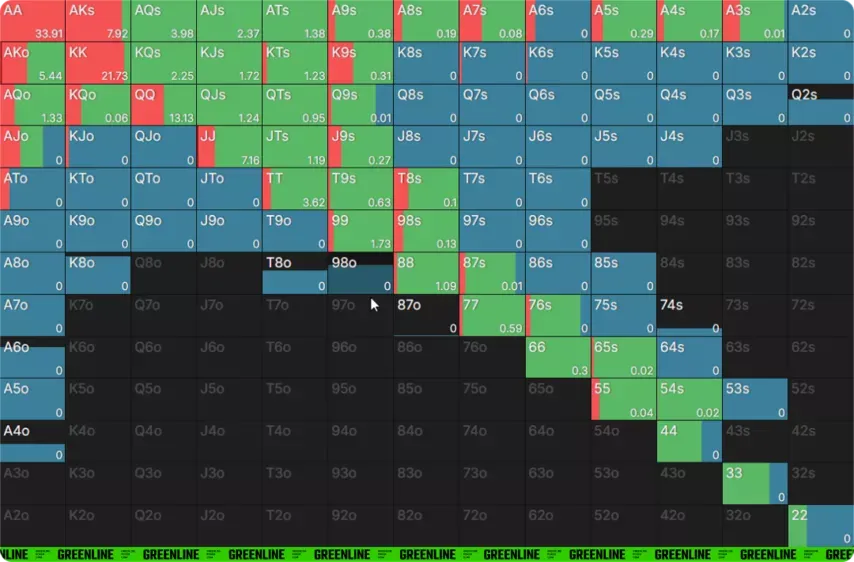
Why will these hands be so hard to win back at NL10? The devil is in the details, or in this case, the rake. The standard rake in many rooms is 5%, but the cap changes. For NL10 it is about 10 bb, and for NL1k it is about 0.3 bb. This means that if we win a standard all-in at NL10 for 100 bb, we will take back not 200 bb, but only 190 bb. And at NL1k in the same situation, we will take back 199.7 bb.
How does this affect the hands? I will explain using a rather crude and simplified example.
Let's take J9s and see what percentage equity this hand has against the SB's 3-bet range. To make things simple, let's pretend that over an infinitely long distance after the flop, we just check/check to the river. In that case, we'll win fairly 36 times out of 100.
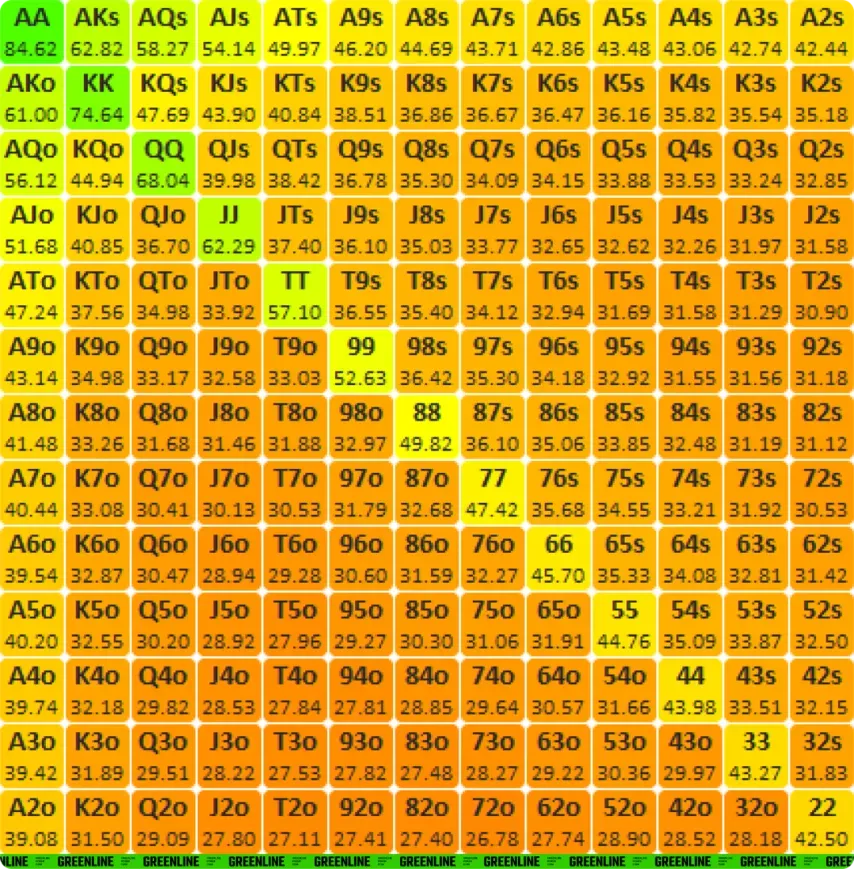
Let's say we opened 3bb and got 3-bet 11bb. We need to call 8 blinds for a pot of 23 (don't forget about 1 extra blind from the BB), for a zero call we need 34.7% equity. Looks good: we need 34.7%, and we have 36%, right? But after the hand, 23 x 0.05 = 1.15bb will be taken from the pot, so in reality you call 8 for a pot of 21.85bb. And with such a layout, for a zero call, we already need 36.6%.
And at NL1000, 35.2% is enough. This creates errors, and marginal hands suffer the most, as in our example with J9s. The same thing will happen postflop: the more your hand increases the pot size, the more it will suffer from rake. Called the flop and turn with a combo draw against an overpair? It doesn't matter who won, in the long run both lost: when going all-in with close equity, everyone just pays the room's rake.
Mistake #7: Copying Someone's Game Without Understanding it
Micro-stakes players often try to copy the play of high-stakes regulars or solver decisions. For example, they might call a 4-bet with small connectors because that's what the solver does. But the solver calls such hands based on its 3-bet and 4-bet ranges, which are very different from the ranges at microstakes. There, 4-bets are more skewed toward strong hands, and such calls become unprofitable.
Let me give you an example: 3-bet pot BU vs SB. Flop: . SB bets 20%, BU calls. Turn: . SB bets 33%, BU calls. River: . SB pushes.
Sometimes students show me screenshots of a solver call and say, "Here the solver calls with AT to a push, so I did too." This is copying without understanding the essence. Yes, indeed, the solver calls AT here.
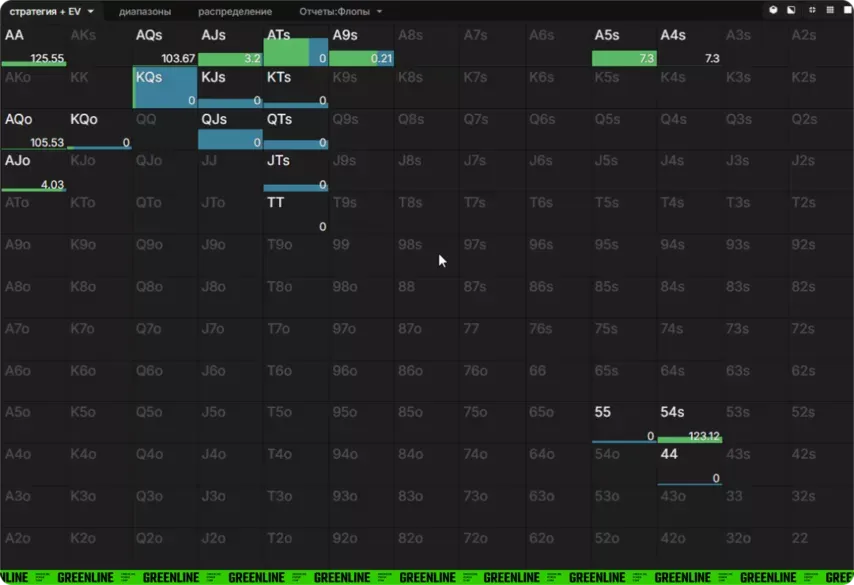
But let's see what the solver bluffs with in the SB's place. 66, 77, 88, and 99 shoves, and JTs shoves with 100% weight.
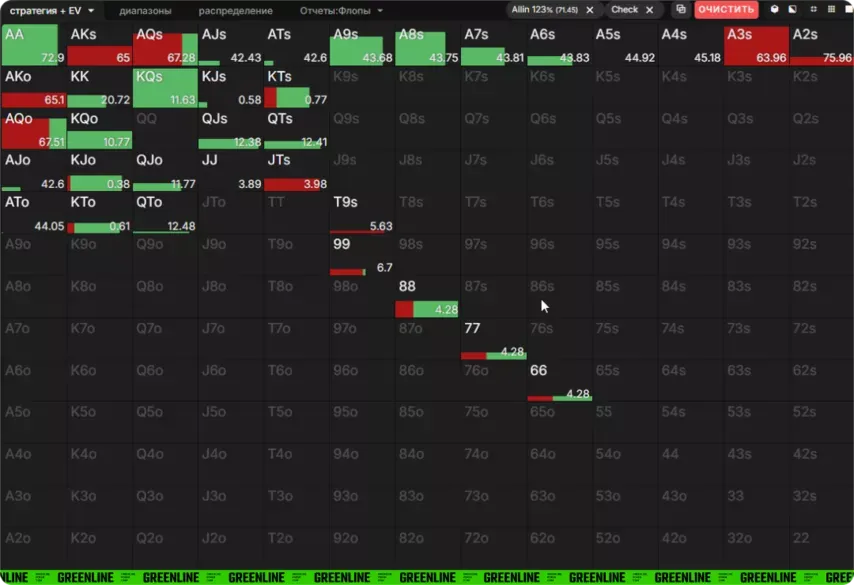
Now answer this question honestly: would anyone in SB's place bet-bet-push with 66? The most that the average regular at micros can do is make a continuation bet with these hands and then check-fold. The solver in BU's place calls wide because SB bluffs wide. If you remove all these counterintuitive hands, BU will start overfolding wildly.
Don't just copy someone else's play or solver's strategies. Always try to understand why they make their decisions and build your strategy based on that understanding.
Mistake #8: Fitting Statistics to Certain Standards
I often see people trying to match the WTSD-WWSF-W$SD (30-50-50) combo they saw at high stakes. But why do high-stakes players play with these stats?
At high limits, opponents give up much less often, and you have to bluff and execute more. The top regulars at micro-stakes, on the contrary, usually do not have the highest WTSD, but a high W$SD (55-56+). At micro-stakes, regs make combinations, bet a lot for value, and often win at showdown. At high-stakes, this will not work. Opponents understand where you are greedily gaining and begin to adapt.
You often hear that folding to 3-bet more than 50% is bad. But where does this figure come from? Solver, for example, recommends folding 65-70% at micro-stakes with high rake. You shouldn't adjust statistics to abstract standards, always think about why this or that player has such stats, and what he does to maintain them. Perhaps you just don't need to focus on that stat as much.
Mistake #9: Making the Game Too Complicated
Even those who consistently play micro-limits with a high win rate, at some point begin to think that they can play even better. This is where the opportunity to overdo it appears.
As long as your strategy works and you are winning, I would not recommend changing it. Yes, when you move to higher limits, where certain moves are punished, it is worth changing something. For example, at micro limits, bet-fold on the river is often played, because no one bluffs on the river. At higher limits, opponents begin to adjust and raise more often.
Let's take a standard example where we can play bet-fold on the river with a clear conscience:
SB opens, BB calls. Flop: , SB bets 33% of the pot, BB calls. Turn: , SB bets 75%, BB calls. River: . What should you do?
The SB still has strong hands in his range that want to bet the river but don't want to bet big, like king dopers and sets. The solver wants to bet 1/3 with them. I'd follow that example here, because most of the BB's bluffs in this spot are turnarounds. He should overbet hands like , , etc. The average opponent at micro-stakes most likely won't do this.
Let's say we bet 1/3 as the solver advises us. Let's see what the solver is bluffing with in the BB position.
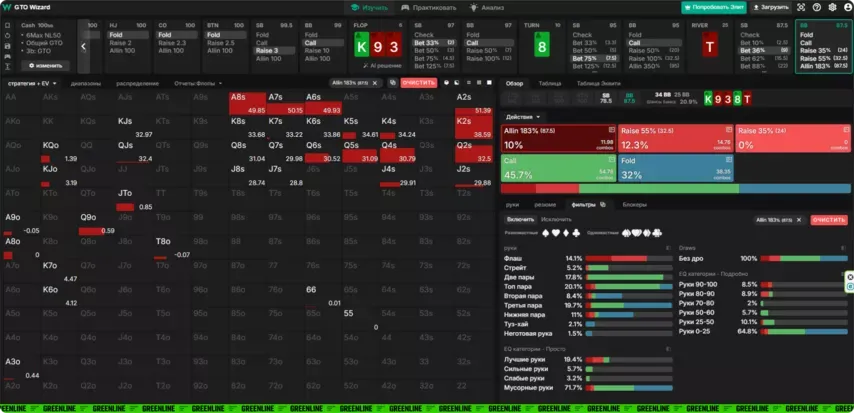
Besides flushes, he pushes as a bluff with a queen of suit, Q9, JT, A8, A9, A3, and all this with a card of suit. Note that with a hand like , the solver practically does not consider a call and pushes with almost 100% frequency.
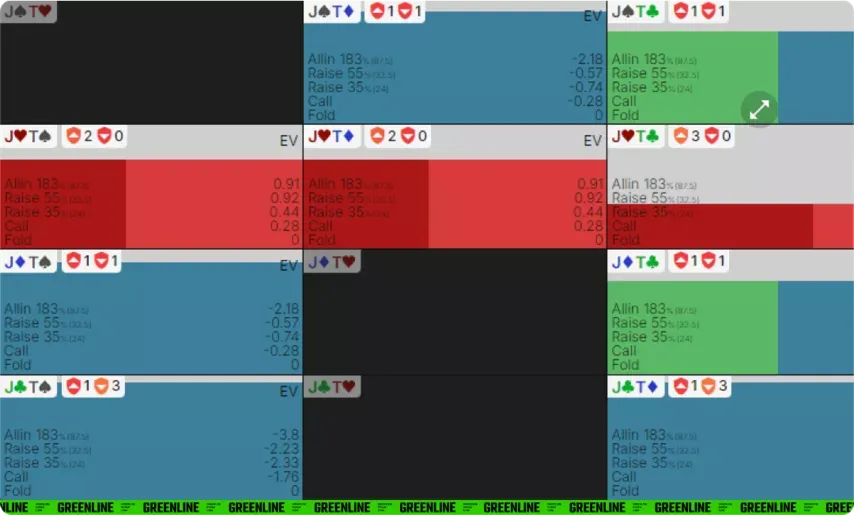
Back to my question: will the average NL10 reg push bluff 100% of the time? ? I don't think so. So I don't see any point in balancing anything here.
My strategy in this spot will be as simple as two kopecks: bet everything average relative to the board (sets, dopers, overpairs, strong top pairs) small and fold to aggression. Bet all my strong hands (flushes, straights) bigger, because I don’t expect the field to often aggro on a bet of a third of the pot and actively turn hands into bluffs.
Don't make your game more difficult by thinking, "If I bet 1/3 of the pot only sets, I'll often get bluff-shoved, so I'll add some nutted hands up to 1/3 for balance." At micro-stakes, if you're not getting punished, don't worry. If the strategy is primitive, but still profitable, that's fine. If it's not profitable, then you should think about what you're doing wrong.
Mistake #10: Trying to Add Mid/High Stakes Strategies into Your Game
Imagine seeing a regular 3x overbet the turn after a small 20% pot bet on the flop. It might seem like an interesting play, but it's probably not going to work at the micros.
The reason is that at high limits, regulars look for unconventional ways to beat their opponents because the standard methods no longer work. So they come up with lines like "bet a third on the flop in a 3bet pot, check in position on the turn on a draw board, and overbet the river" to get calls from bluff catchers. But at micro limits, players don't think like that, they'll see a big bet, get scared, and fold, so you shouldn't adopt such strategies.
The same goes for the frequency of calls and raises on the river. At high stakes, players are good at turning made hands into bluffs: if you bet small, they can check-push third or second pair and turn it into a bluff. At low stakes, they don't do that, and in the case of a bet-call on the river, you'll most often see your opponent with the nuts.
You can learn to play at micro limits in GreenLine for free as part of the GreenLine Junior project. Three group lessons per week, access to video courses from the best coaches of the main team, and maximum freedom. There are no contracts – you choose the limits and rooms yourself. After 50,000 hands there will be 1-on-1 training and the opportunity to get into the main team.
Find out more and apply:
https://gipsyteam.poker/greenline-junior
If you are interested in backing and you can show a positive win rate at NL10/PL10 (or at higher limits), apply to the main team. There are 1-on-1 training sessions every 20k hands, excellent conditions for the game, and access to closed online poker fields with amateurs.
https://gipsyteam.poker/greenline-poker






